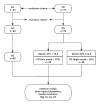Affective and chronic fatigue symptoms are associated with serum neuronal damage markers in Parkinson's disease
- PMID: 40596358
- PMCID: PMC12216631
- DOI: 10.1038/s41598-025-07735-7
Affective and chronic fatigue symptoms are associated with serum neuronal damage markers in Parkinson's disease
Abstract
Parkinson's disease (PD) is frequently accompanied by mood and chronic fatigue syndrome (CFS) symptoms. The aim of this study is to examine whether the affective and CFS symptoms due to PD are associated with serum biomarkers of neuronal injury in association with immune activation and insulin resistance. Using a case (70 PD patients) control (60 healthy controls) study design, we assessed affective and CFS symptoms, measured the peripheral immune-inflammatory response system (IRS) using interleukin-6 (IL-6), IL-10, zinc, and calcium levels, the Homeostasis Model Assessment 2 insulin resistance (HOMA2IR) index, and serum brain injury markers including S100 calcium-binding protein B (S100B), neuron-specific enolase (NSE), phosphorylated tau217 (pTau217), and glial fibrillary acidic protein (GFAP). The aim is to examine whether immune, IR, and/or brain injury biomarkers determine affective and CFS symptoms due to PD. PD patients showed increased affective and CFS scores, IRS activation, HOMA2IR, NSE, GFAP, pTau217, and S100B levels as compared to controls. A large part (52.5%) of the variance in the mood + CFS score was explained by the regression on NSE, S100B, HOMA2IR index, IL-10 (all positively), and calcium (inversely). The HOMA2IR and IRS indices were significantly associated with all 4 brain injury biomarkers. A large part of the variance in the latter markers (37.0%) was explained by the cumulative effects of the IRS and HOMA2IR indices. IRS activation and IR in patients with PD contribute to damage to glial cell projections and type III intermediate filament, which in turn contribute to affective and CFS symptoms.
Keywords: Biomarkers; Chronic fatigue syndrome; Depression; Inflammation; Mood disorders; Neuroimmune.
© 2025. The Author(s).
Conflict of interest statement
Declarations. Competing interests: The authors declare no competing interests. Ethics approval and consent to participate: The study has been approved by the institutional ethics committee of the University of Kufa (2109/2023). The study adhered to both Iraqi and international ethical and privacy laws, including the International Conference on Harmonization of Good Clinical Practice, the Belmont Report, the CIOMS Guidelines, and the World Medical Association’s Declaration of Helsinki. Before participating in this study, each subject provided written informed consent.
Figures





Similar articles
-
Effects of Selective Head-and-Neck Cooling on Brain Injury-Related Biomarker Levels and Symptom Rating Following a Boxing Bout: Protocol for an Exploratory Randomized Trial.JMIR Res Protoc. 2025 Jun 16;14:e68954. doi: 10.2196/68954. JMIR Res Protoc. 2025. PMID: 40523276 Free PMC article.
-
Association of Blood-Based Biomarkers and 6-Month Patient-Reported Outcomes in Patients With Mild TBI: A CENTER-TBI Analysis.Neurology. 2025 Jan 14;104(1):e210040. doi: 10.1212/WNL.0000000000210040. Epub 2024 Dec 9. Neurology. 2025. PMID: 39652812 Free PMC article.
-
Increased galanin-galanin receptor 1 signaling, inflammation, and insulin resistance are associated with affective symptoms and chronic fatigue syndrome due to long COVID.PLoS One. 2025 Mar 6;20(3):e0316373. doi: 10.1371/journal.pone.0316373. eCollection 2025. PLoS One. 2025. PMID: 40048451 Free PMC article.
-
Correlation of levels of neuronal and glial markers with radiological measures of infarct volume in ischaemic stroke: a systematic review.Cerebrovasc Dis. 2012;33(1):47-54. doi: 10.1159/000332810. Epub 2011 Dec 1. Cerebrovasc Dis. 2012. PMID: 22133844
-
S100B, GFAP, UCH-L1 and NSE as predictors of abnormalities on CT imaging following mild traumatic brain injury: a systematic review and meta-analysis of diagnostic test accuracy.Neurosurg Rev. 2022 Apr;45(2):1171-1193. doi: 10.1007/s10143-021-01678-z. Epub 2021 Oct 28. Neurosurg Rev. 2022. PMID: 34709508
Cited by
-
Neuroimmune, metabolic and oxidative stress pathways in major depressive disorder.Nat Rev Neurol. 2025 Jul 14. doi: 10.1038/s41582-025-01116-4. Online ahead of print. Nat Rev Neurol. 2025. PMID: 40659853 Review.
References
-
- Saini, N. et al. Motor and non-motor symptoms, drugs, and their mode of action in parkinson’s disease (PD): a review. Med. Chem. Res., 1–20 (2024).
-
- Silva, A. B. R. L. et al. Premotor, nonmotor and motor symptoms of parkinson’s disease: a new clinical state of the Art. Ageing Res. Rev.84, 101834 (2023). - PubMed
-
- Hirsch, E. C. & Hunot, S. Neuroinflammation in parkinson’s disease: a target for neuroprotection? Lancet Neurol.8, 382–397 (2009). - PubMed
MeSH terms
Substances
LinkOut - more resources
Full Text Sources
Medical
Miscellaneous

